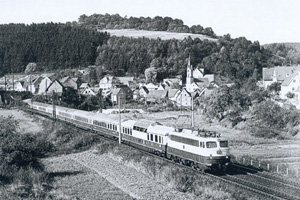| |
Epoch III
Introduction
A new start
The first trains after the war
The first network of long-distance trains
Moving forward, more trains, more comfort, more regularity
Pre war rolling stock again in service
The start of an international long-distance network
The blue network of fast express trains
The modern era, the rise of electric locomotives
The modern diesel locomotive is coming
A new class of coaches
The third class is abandoned
The last new steam engine
A new prestious network, the Trans Europ Express
The Rheingold, from 1962 again exclusive
A new star on rails, the electric locomotive E 03
The Rheingold, from 1962 again exclusive
Inspired from the pre war Rheingold, the Deutsche Bundesbahn ordered in 1960 the "Zentralamt" in Minden to develop a number of special coaches for the new Rheingold train. The DB wanted to give back the Rheingold the special status which it had before the war. And therefore the train must consist of special rolling stock. The coaches must had a length of at least 26,4 meter and a width of 2,825 meter. The coaches must be suitable for speeds of 160 km/h. And the coaches had to exceed all existed rolling stock in design and comfort.
The manufacturers Credé, Wegmann and Waggon und Maschinenbau GmbH in Donauwörth (WMD) were in charge of the production of the coaches. The dining coaches, which belonged to the DSG, were produced at Orenstein & Koppel in Berlijn.
With the construction of the coaches they made use of the experiences done with the construction of the TEE trainsets VT 11.5. The most striking differences was that the DB choosed again for the concept of coaches pulled by a locomotive. In total the industry made four different types of coaches for the Rheingold trains, among them a compartment coach, a saloncoach, a panorama/bar coach and a dining coach. Initially there were in 1962 10 compartment coaches, 5 saloncoaches, 3 panorama/bar coaches and 2 dining coaches. In 1963 the DB ordered again 23 more Rheingold coaches for the Rheinpfeil trains. For more information about the coaches, see also the Rheingold/TEE coaches in the coach section.
The DB could set up two complete Rheingold trains with a total of 307 seats. Eventually they could insert extra coaches in time of busyness. The coaches were suitable for speeds of 160 km/h and were all provided with a climate control with air-conditioning. All coaches were first class only.
The DB wanted also a special locomotive for the Rheingold. After many proposals for a new locomotive construction, the DB decided ultimately for an improved and modified version of the electric locomotive E 101. By changing the gear ratios, the locomotives got a maximum speed of 160 km/h. The locomotives got also more aerodynamic fronts (from the E 10 288 all E 10 locomotives got these fronts), sideskirts, bufferskirts and one long ventilation grid on each side. Also the bogies and suspension were modified.
Because the Rheingold locomotives (E 10 1265-1270) were not finished at the time when the new Rheingold was introduced, the DB decided to ride the first Rheingold trains from May 1962 with ordinary E 10.1 locomotives. The locomotives got modified gear ratios so that the maximum speed was 160 km/h. The original E 10 239-244 locomotives were renumbered to E 10 1239-1244. The locomotives got also the same livery as the Rheingold coaches. The locomotives got their orginal numbers back in the fall of 1962 when the "real" Rheingold locomotives were delivered. The final Rheingold locomotives got the indication E 10.12-13. See also the description of the E 10.12-13.
 | | The Rheingold with behind the E 10.12-13 locomotive the panorama coach and the eye-catching dining coach |
On 27 May 1962, with the summer timetable, the new Rheingold had her first service with the new special built rolling stock. The Rheingold was running as F 9/10 on the relation Amsterdam/Hoek van Holland-Utrecht-Emmerich-Keulen-Mainz-Karlsruhe-Basel SBB. The Rheingold offered in combination with "Kurswagens" from for example the Rheinpfeil very good relations with Milano, Chur and München. The Rheingold was the first train after the war which was running with a speed of 160 km/h. In 1963/64 the Rheinpfeil was also running at a speed of 160 km/h.
During the years the railway lines were more and more improved. For example in 1963 the so called "Vogelfluglinie" was reopened. This line was situated between Lübeck and Puttgarden and further to Denmark. Also the major part of the north-south relation was electrified, the part between Hannover, Fulda and Gemünden. Together with the production of more express train coaches and locomotives and an improved timetable there originated a tight network of domestic and international express trains. Also the Rheinpfeil was provided with the same rolling stock as the Rheingold. Because of that 23 more Rheingold coaches were ordered. Also five more Rheingold locomotives of class E 10.12-13 were ordered. These were the E 10 1308-1312. And also here, before these locomotives were delivered, the Rheinpfeil was pulled by ordinary improved E 10.1 (E 10 250-254) locomotives.
|
